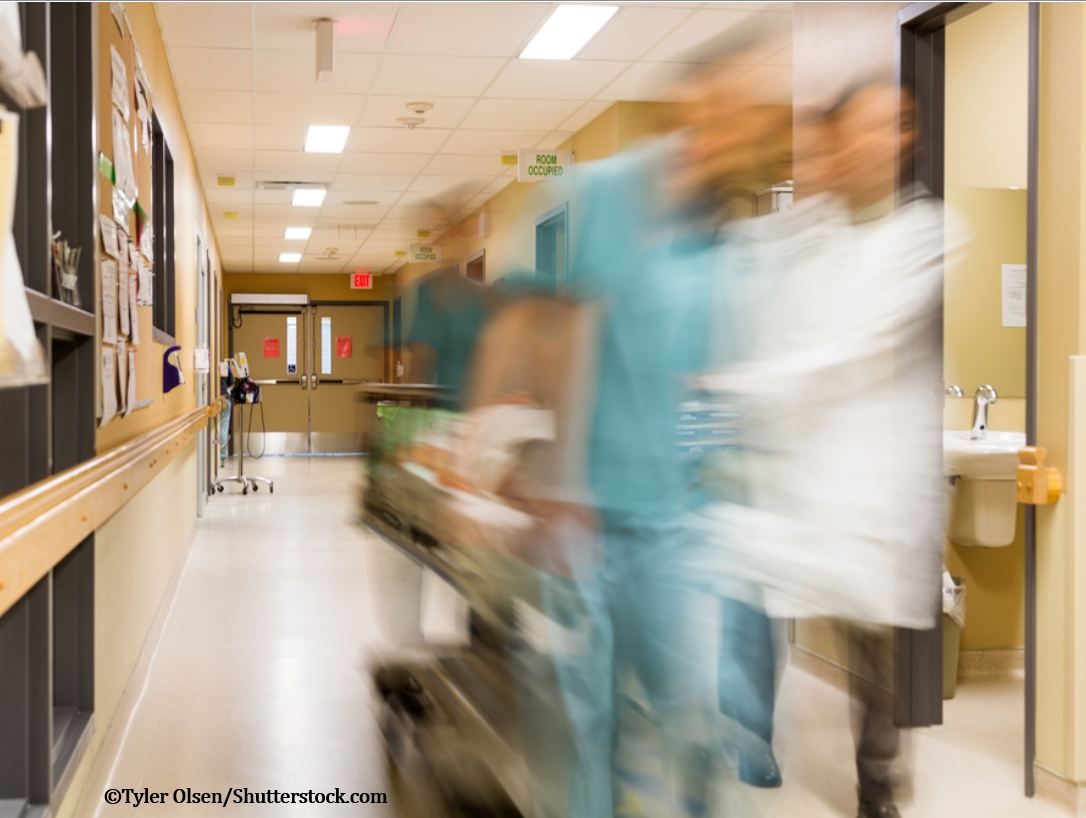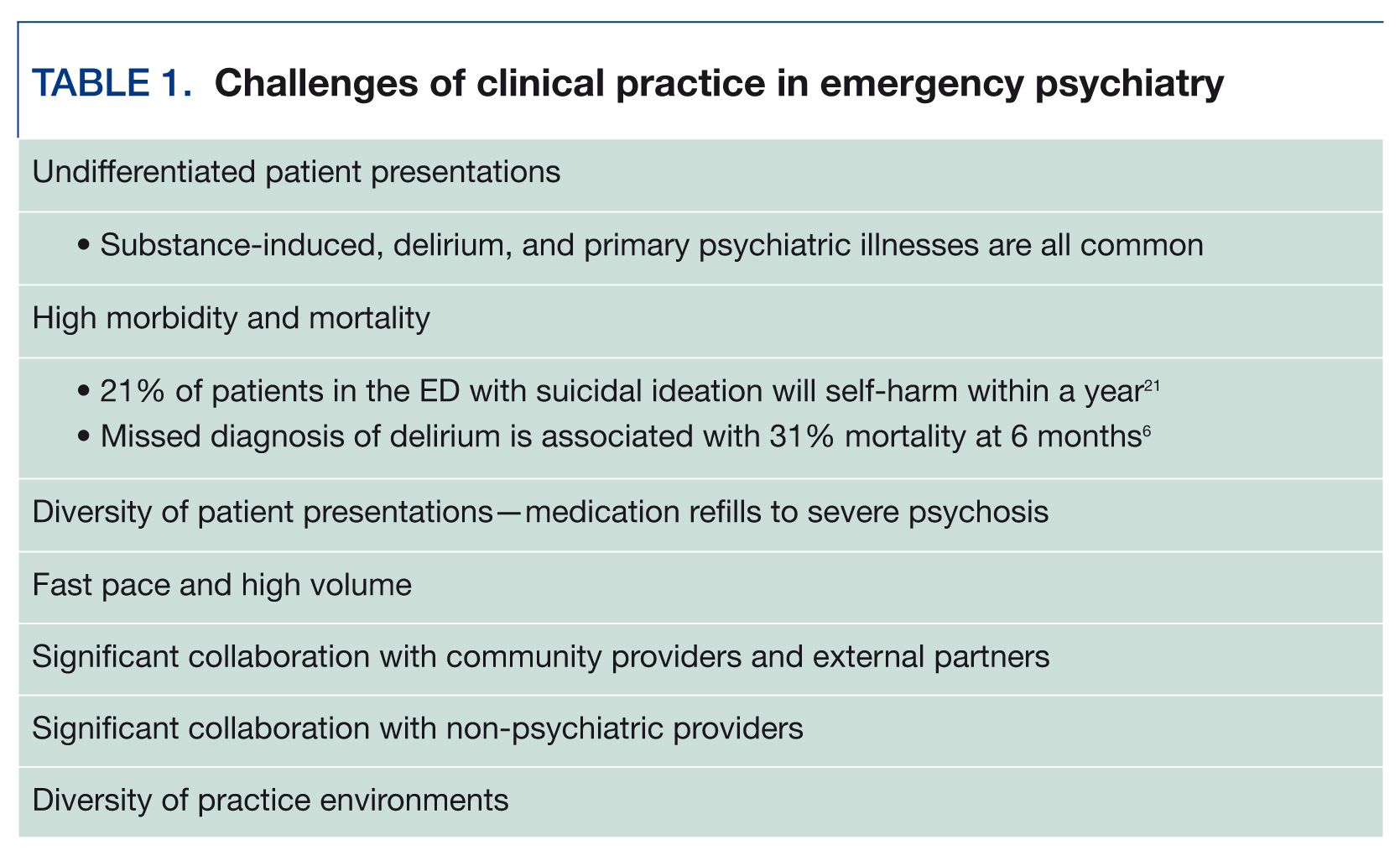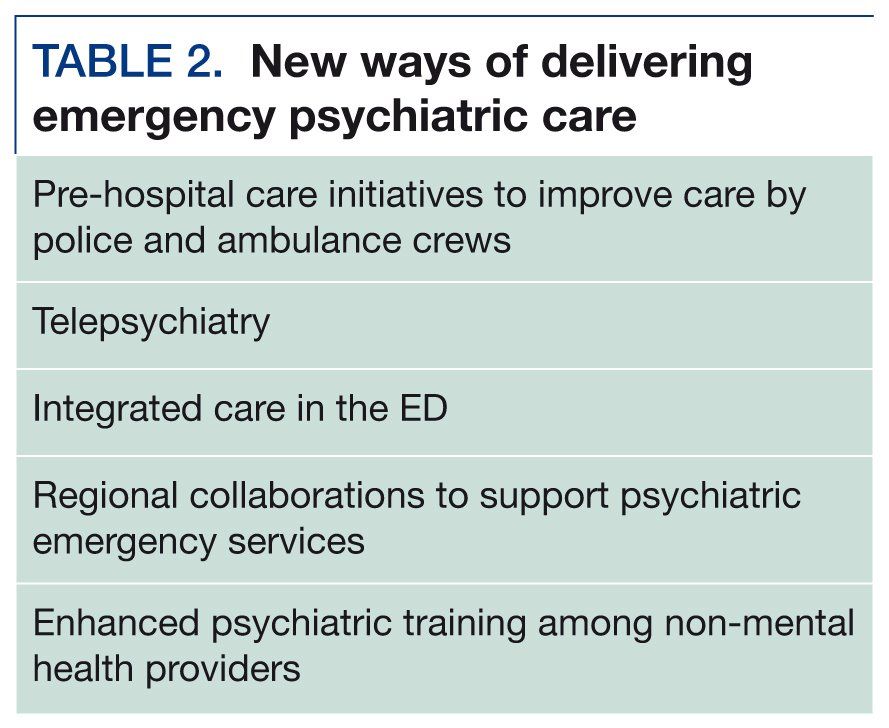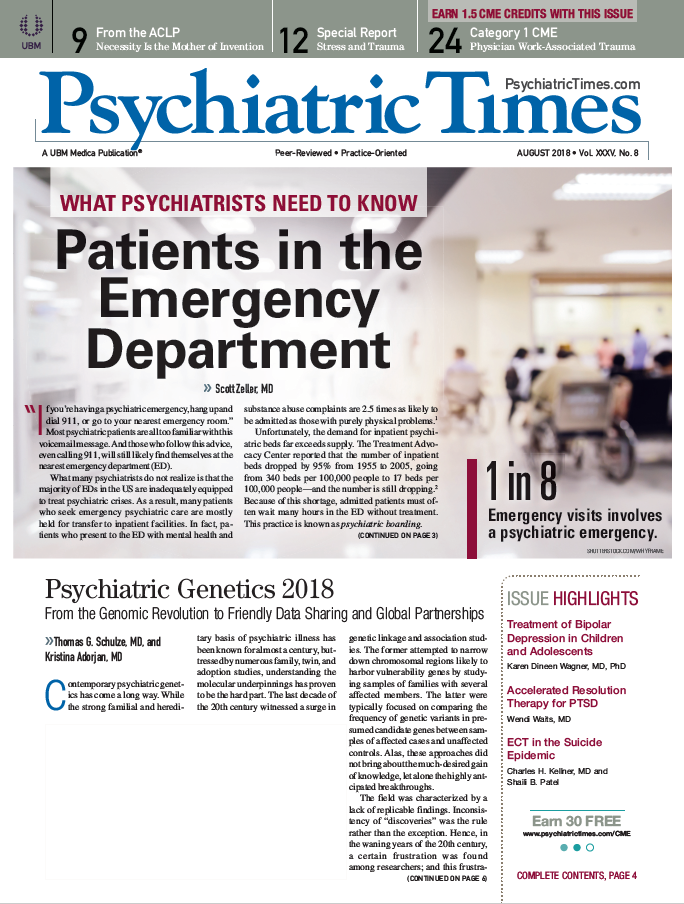Publication
Article
Psychiatric Times
Necessity Is the Mother of Invention: Emergency Psychiatry’s Era of Innovation
This article discusses the peculiarities of emergency psychiatric practice and reviews innovations in models of care delivery designed to overcome the challenges of this subspecialty.
©Tyler Olson/Shutterstock.com

TABLE 1. Challenges of clinical practice in emergency psychiatry

TABLE 2. New ways of delivering emergency psychiatric care

FIGURE. Innovations to improve each step of emergency psychiatry care

Emergency department (ED) visits for psychiatric complaints are increasingly common. The 1% to 3% of ED patients who screen positive for suicidal ideation comprise a population at heightened risk of completing suicide.1,2 While emergency psychiatric presentations are often associated with serious mental illness, patients of all acuity levels present in this setting. The most common psychiatric presentations in the ED are for anxiety, depression, or stress reactions.3
Providing treatment to these patients in the ED introduces complexity of care that emergency psychiatrists are attempting to address with a mix of service delivery models. This article discusses the peculiarities of emergency psychiatric practice and reviews innovations in models of care delivery designed to overcome the challenges of this subspecialty.
A difficult place to provide good care
The growth of psychiatric care in ED settings is driven by several factors. Foremost is a trend towards treating sicker patients in less restrictive care environments. Increasingly, patients with significant psychiatric disease are being treated in outpatient and integrated care environments. At the same time, long-term inpatient and residential treatment has become scarcer.4 Thus, EDs become the backstop for highly acute patients who present with suicidality, violent thoughts, intoxication, and/or acute psychosis. Other factors driving this trend towards less restrictive treatments include financial incentives and the ready accessibility of emergency care compared with the limited availability of community mental health facilities. Also driving the trend toward acute care in the ED is the American epidemic of psychiatric illnesses, particularly substance use disorders, that are associated with increased use of emergency services.5
Delivering psychiatric care in the ED is not easy. Most emergency medicine providers feel comfortable managing common psychiatric presentations, however, their expertise does not always extend to managing sicker patients or those requiring more nuanced psychiatric assessments-for example, patients with personality disorders and chronic suicidal ideation, or patients with schizophrenia whose ability to care for themselves is called into question.
Patients with psychiatric illness frequently have undertreated medical illness that requires attention and care coordination. Delirium is commonly missed among ED patients, and longer ED stays are associated with an increasing risk of incident delirium.6 Frequent changes of staff, lack of specialty consultants, constant sensory stimulation, and ill-suited infrastructure all render EDs a challenging environment in which to deliver care for patients in psychiatric crisis. Table 1 summarizes these and other clinical challenges unique to the field of emergency psychiatry.
This confluence of psychiatric illness, medical comorbidity, and systemic challenges adversely affects ED patients’ psychiatric care. The duration of stay is 42% longer for patients with psychiatric complaints compared with patients with medical illness.7 Disposition for patients is a particular challenge. Many general hospitals have closed their inpatient psychiatric units, and free-standing behavioral hospitals are less frequently equipped to manage medical comorbidity, treat complicated withdrawal syndromes, or safely treat agitated patients. Nationally, 73% of patients presenting for suicidal ideation to the ED are hospitalized-a rate triple that for medical complaints.8 Helping patients access treatment is thus a challenge driven by both high demand for service and also inherent limitations of existing inpatient facilities to meet patients’ needs. How, then, can we help patients in crisis receive great psychiatric care?
Emergency psychiatry: a subspecialty to the rescue
The subspecialty of emergency psychiatry has attracted growing interest among a range of clinicians who are drawn to its diverse patient population, highly multidisciplinary work environment, and fast pace. There is no Accreditation Council for Graduate Medical Education (ACGME)-accredited subspecialty pathway for emergency psychiatry; rather, psychiatrists often bring their interests in consultation-liaison, addiction, or forensic psychiatry to their ED work. Other clinicians enjoy providing psychotherapy to patients in crisis and appreciate the challenge of quickly building rapport and framing treatment for these patients in the ED.
There are no data on the number of psychiatrists working in EDs. In many locations, the need for psychiatric consultation is filled by advanced practitioners and licensed social workers working alongside emergency medicine providers. Professional organizations that support emergency psychiatry-such as the Academy of Consultation-Liaison Psychiatry’s Emergency Psychiatry Special Interest Group and the American Association of Emergency Psychiatry-include robust participation by non-psychiatric clinicians.
Interest in the field often begins during psychiatry residency. The ACGME requires residents in psychiatry to experience emergency psychiatry “in an organized, supervised psychiatric emergency service” that “must include crisis evaluation and management, and triage of psychiatric patients.”9 The ACGME’s emergency medicine requirements do not require specific experience managing behavioral presentations.
The challenges of growing volume and acuity among psychiatric patients in the ED have prompted emergency psychiatrists to work alongside colleagues in medicine and ED leadership to imagine systems to improve the care of behavioral emergencies in their communities. These models typically arise to meet demands of emergency medicine clinicians and hospital systems and are designed to accommodate constraints of staff, facilities, and budget.
New ways forward
Just as communities and hospital systems vary, so too must models for delivering emergency psychiatric care. Table 2 summarizes some of the novel efforts that have been developed to meet the demand for high-quality, affordable psychiatric care that addresses the challenges of managing behavioral emergencies in the ED. These models comprise an overarching philosophy that EDs must provide active treatment of psychiatric emergencies-not merely triage patients to the next step in care.
Pre-hospital care. Management of behavioral emergencies begins in the community-well before patients’ arrival to the ED. Emergency psychiatrists have partnered with police departments and other first responders to provide training in the recognition and initial management of psychiatric emergencies. Typical skills include increasing awareness of the prevalence of psychiatric illness in the community and teaching verbal de-escalation to help patients in crisis. Crisis Intervention Training (CIT) is a national model for police departments to use for working with mentally ill patients in the community; some cities now train all officers in CIT. For ambulance crews, researchers have investigated the utility of novel medications for treating agitation quickly and safely prior to arrival in the ED.10
These efforts build on the precedents set by community-based psychiatrists in promulgating patient-centered, easily accessible interventions such as mobile crisis teams and telephone crisis hotlines. Education among pre-hospital providers also encourages use of diversion facilities (eg, crisis centers) over EDs or jails.
Telepsychiatry. The need to deliver 24/7 care to rural and low volume EDs may be met in part through telepsychiatry services. ED diagnoses made via telepsychiatry are correlated with those provided by an in-person psychiatrist while enhancing outpatient follow-up, reducing hospital admissions, and decreasing costs.11,12 Large health systems and academic medical centers may utilize telepsychiatry to extend specialty consultation expertise to outlying EDs, urgent care centers, and partnership hospitals.
Telepsychiatry is well-suited for patients presenting in crisis who are able to participate and benefit from a therapeutic interview; patients with comorbid presentations may also benefit from evaluation by a telepsychiatry specialist. However, this medium is more limited for providing verbal de-escalation or management of disruptive behaviors and acute agitation.
Integrated care. Integrated behavioral health has transformed the delivery of mental health care in primary care settings. Several institutions including the Stanford Medical Center in California and the Denver Health Medical Center in Colorado have piloted integrated care models in ED and urgent care settings. Initial data are highly promising.
The Stanford experience has demonstrated a 90% decrease in duration of stay for psychiatric patients in the ED and improved discharge rates by 47%.13 In the ED, integrated care expands the availability of psychiatric services beyond the traditional consultation for suicidal ideation. For example, these models facilitate the treatment of patients with somatic symptom disorders, chronic pain, and high ED utilization. The presence of an integrated care provider also enhances the skill set of medicine providers who benefit from “at the elbow” consultation expertise provided by an integrated mental health provider.
Sustainable regional collaborations. Not all health care facilities have the patient volume to justify a dedicated psychiatric emergency service, 24/7 psychiatrist coverage, and dedicated staff on their own; yet when collaborating with other institutions, it becomes feasible to build and sustain such a service. The Unity Center for Behavioral Health in Portland, Oregon offers emergency and inpatient psychiatric service and is supported by 4 different health care systems in that city.
By pooling resources to fund a regional psychiatric emergency service, health systems ease patients’ access to psychiatric care while reducing duration of stay and psychiatric boarding in their EDs.14 Bringing together clinicians passionate about emergency psychiatry enable programs to cultivate trauma-informed approaches to emergency psychiatry including the use of multidisciplinary assessment models and peer support services.
Enhanced training in emergency medicine. Just as most mental health care is provided in primary care settings, emergency medicine practitioners will continue to see the bulk of patients with psychiatric illness. The American College of Emergency Physicians is collaborating with specialty societies in emergency psychiatry to enhance the training of emergency medicine physicians in behavioral emergencies. This training includes assessing suicide risk, identifying delirium, managing agitation, and coordinating care for boarding psychiatric patients. These teaching efforts extend to the range of advanced practitioners working in the ED.
New interventions for behavioral emergencies
These service models enhance access and quality of care in emergency psychiatry across diverse health systems. They also recognize the need to improve services at different points of the patient’s ED visit, from initial contact in the community to facilitating discharge. The Figure illustrates how innovations are improving care at each step of the psychiatric patient’s ED visit. These platforms also provide a means to disseminate innovations in emergency psychiatric treatment.
Trauma-informed care. Trauma-informed care (TIC) is a treatment approach that recognizes harmful consequences of trauma on the well-being of individuals.15 In psychiatric care, TIC improves patient satisfaction and encourages collaborative, healing partnerships among patients and providers. Rarely can a busy medical ED provide this environment, but dedicated emergency psychiatry programs routinely integrate TIC into treatment planning. This includes the use of patient-centered de-escalation techniques such as the availability of non-pharmacologic relaxation tools like stress balls and scented lotions; peer counseling; and dedicated training to familiarize staff with TIC principles.
Peer support. Peer counselors comprise a growing category of health care workers who use their lived experience with illness to facilitate treatment. Behavioral health peer coun-selors are increasingly utilized in emergency service settings to engage patients ambivalent about mental health treatment, uncertain as to positive behavioral change, or in need of linkage to care. In EDs, peer counselors often interact with patients with substance use disorders or chronic mental illness; some programs include follow up with patients after ED discharge. The evidence base supporting peer services remains small but is growing as these services become increasingly available. Nationally, the application of peer counseling will develop heterogeneously alongside similarly varied models for emergency psychiatric care.
Psychological and medication treatments. New discoveries will influence the provision of emergency psychiatric treatment. As in all psychiatric fields, these discoveries will reflect the breadth of psychiatric practice. There is increasing emphasis on the use of verbal de-escalation for the management of agitation, and online training programs make evidence-based techniques freely available for all health care staff.16 Using standardized rating scales for evaluating agitation helps ED staff feel safer and better prepared in managing agitation.17 Finally, new medication approaches are fast-changing the face of emergency psychiatric care, from the use of intramuscular ketamine for acute agitation to the pro-active use of medication-assisted treatments of substance use disorders.18-20
Emergency psychiatrists are rising to the challenge
Providing immediately accessible, high quality emergency psychiatric care continues to be a challenge for many communities. Obstacles to providing care include economic constraints, inconsistent training in emergency psychiatry among clinicians, the lack of a scientific evidence base for the field, and the prevalence of treatment-resistant illness. Nonetheless, a growing number of emergency psychiatrists are motivated to enhance the care of psychiatric patients through new models of service delivery and innovations in clinical care. Vital to the continued growth of this subspecialty and the improved treatment of our patients are recognition of this subspecialty among the psychiatric community and continued interest among new generations of psychiatrists.
Acknowledgements-Dr Simpson would like to thank members of the Academy of Consultation-Liaison Psychiatry’s (ACLP) Emergency Psychiatry Special Interest Group for their superb work in emergency psychiatry-and their assistance with this work. He also thanks Dr Christina Wichman DO, FACLP and ACLP’s leadership for their continued, robust support for emergency psychiatry.
The Academy is the professional home for psychiatrists providing collaborative care bridging physical and mental health. Over 1200 members offer psychiatric treatment in general medical hospitals, primary care, and outpatient medical settings for patients with comorbid medical conditions.
Disclosures:
Dr Simpson is Medical Director, Psychiatric Emergency Services, Denver Health Medical Center.
References:
1. Ting SA, Sullivan AF, Miller I, et al. Multicenter study of predictors of suicide screening in emergency departments. Acad Emerg Med. 2012;19:239-243.
2. Halmer TC, Beall RC, Shah AA, Dark C. Health Policy Considerations in Treating Mental and Behavioral Health Emergencies in the United States. Emerg Med Clin North Am. 2015;33:875-891.
3. Agency for Healthcare Research and Quality. Trends in Emergency Department Visits Involving Mental and Substance Use Disorders, 2006-2013. https://www.hcup-us.ahrq.gov/reports/statbriefs/sb216-Mental-Substance-Use-Disorder-ED-Visit-Trends.jsp. Accessed July 10, 2018.
4. ACEP Emergency Medicine Practice Committee. Care of the psychiatric patient in the emergency department: a review of the literature. Irving, TX: American College of Emergency Physicians; October 2014.
5. Office of the Surgeon General. Facing Addiction in America. The Surgeon General’s Report on Alcohol, Drugs, and Health. Washington (DC): US Department of Health and Human Services; 2016: 382.
6. Kakuma R, du Fort GG, Arsenault L, et al. Delirium in older emergency department patients discharged home: effect on survival. J Am Geriatr Soc. 2003;51:443-450.
7. Hasemann W, Grossmann FF, Stadler R, et al. Screening and detection of delirium in older ED patients: performance of the modified Confusion Assessment Method for the Emergency Department (mCAM-ED): a two-step tool. Intern Emerg Med. 2017;22:19.
8. Owens PL, Fingar KR, Heslin KC, et al. Emergency department visits related to suicidal ideation, 2006-2013. Healthcare Cost and Utilization Project (HCUP) Statistical Briefs. Rockville, MD. 2017.
9. Accreditation Council for Graduate Medical Education. ACGME program requirements for graduate medical education in psychiatry. 2017. https://www.acgme.org/Portals/0/PFAssets/ProgramRequirements/400_psychiatry_2017-07-01.pdf. Accessed July 10, 2018.
10. Burnett AM, Salzman JG, Griffith KR, et al. The emergency department experience with prehospital ketamine: a case series of 13 patients. Prehospital Emerg Care. 2012;16:553-559.
11. Seidel RW, Kilgus MD. Agreement between telepsychiatry assessment and face-to-face assessment for emergency department psychiatry patients. J Telemed Telecare. 2014;20:59-62.
12. Narasimhan M, Druss BG, Hockenberry JM, et al. Impact of a telepsychiatry program at emergency departments statewide on the quality, utilization, and costs of mental health services. Psychiatr Serv. 2015;66:1167-1172.
13. Elanouari A, England S, Hartoch A. Addressing mental health in the emergency department: the development of a complex care manager role. Collab Case Manage. 2018;65:3-6.
14. Zeller S, Calma N, Stone A. Effects of a dedicated regional psychiatric emergency service on boarding of psychiatric patients in area emergency departments. West J Emerg Med. 2014;15:1-6.
15. Reeves E. A synthesis of the literature on trauma-informed care. Issues Ment Health Nurs. 2015;36:698-709.
16. Simpson SA, Rylander M. Verbal de-escalation of the agitated patient. Chapter 1: Identification and assessment of agitation. 2017. https://youtu.be/musgq94q8GQ. Accessed July 10, 2018.
17. Simpson SA, Pidgeon M, Nordstrom K. Using the Behavioral Activity Rating Scale as a vital sign in the psychiatric emergency service. Colorado J Psychiatry Psychol. 2016;2:61-66.
18. Riddell J, Tran A, Bengiamin R, et al. Ketamine as a first-line treatment for severely agitated emergency department patients. Am J Emerg Med. 2017;35:1000-1004.
19. D’Onofrio G, O’Connor PG, Pantalon MV, et al. Emergency department-initiated buprenorphine/naloxone treatment for opioid dependence: a randomized clinical trial. JAMA. 2015;313:1636-1644.
20. Bernstein SL, D’Onofrio G, Rosner J, et al. Successful tobacco dependence treatment in low-income emergency department patients: a randomized trial. Ann Emerg Med. 2015;66:140-147.
21. Miller IW, Camargo CA, Jr, Arias SA, et al. Suicide prevention in an emergency department population: the ED-SAFE study. JAMA Psychiatry. 2017;74:563-570.







